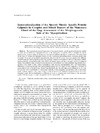Please use this identifier to cite or link to this item:
https://accedacris.ulpgc.es/jspui/handle/10553/73671
| Title: | Immunolocalization of the smooth muscle-specific protein calponin in complex and mixed tumors of the mammary gland of the dog: Assessment of the morphogenetic role of the myoepithelium | Authors: | Espinosa De Los Monteros Y Zayas, Antonio Millan, M. Y. Ordas, J Carrasco, L Reymundo, C Martín de las Mulas, J. |
UNESCO Clasification: | 310907 Patología | Keywords: | Calponin Complex Tumors Dogs Immunohistochemistry Mammary Gland, et al |
Issue Date: | 2002 | Journal: | Veterinary Pathology | Abstract: | The immunohistochemical expression of the smooth muscle-specific protein calponin was studied to assess the contribution of myoepithelial cells to the histogenesis of spindle cells of complex and mixed tumors of the mammary gland of the dog and the origin of cartilage and bone in mixed tumors. Formalin-fixed tissues from 55 benign and malignant tumors (49 also containing surrounding normal mammary gland) were evaluated. Periacinar and periductal myoepithelial cells of all the 49 normal mammary glands were diffusely stained by the anti-human calponin monoclonal antibody. Calponin was found in 53 (98%) of the tumors studied, reacting with the myoepithelium-like cells of 86% of benign tumors and their remnants in 85% of malignant tumors. Five different types of calponin-immunoreactive myoepithelial cells were identified: hypertrophic myoepithelial cells, fusiform. cells, stellate myoepithelial cells, rounded (myoepithelial) cells, and chondroblasts. Differences in staining intensity and staining pattern among these five types of cells suggested a transition of myoepithelial cells to chondroblasts. Stromal myofibroblasts also showed calponin immunoreactivity, but they did not react with a cytokeratin 14 monoclonal antibody, which recognizes myoepithelial cells in mammary gland. Calponin appears to be a very sensitive marker of normal and neoplastic myoepithelium in the canine mammary gland, and its identification in different cell types of complex and mixed tumors of the mammary gland of the dog suggests a major histogenetic role for myoepithelial cells. | URI: | https://accedacris.ulpgc.es/handle/10553/73671 | ISSN: | 0300-9858 | DOI: | 10.1354/vp.39-2-247 | Source: | Veterinary Pathology [ISSN 0300-9858], v. 39 (2), p. 247-256, (Marzo 2002) |
| Appears in Collections: | Artículos |
SCOPUSTM
Citations
50
checked on Jun 8, 2025
WEB OF SCIENCETM
Citations
43
checked on Jun 8, 2025
Page view(s)
125
checked on Mar 9, 2024
Download(s)
165
checked on Mar 9, 2024
Google ScholarTM
Check
Altmetric
Share
Export metadata
Items in accedaCRIS are protected by copyright, with all rights reserved, unless otherwise indicated.
